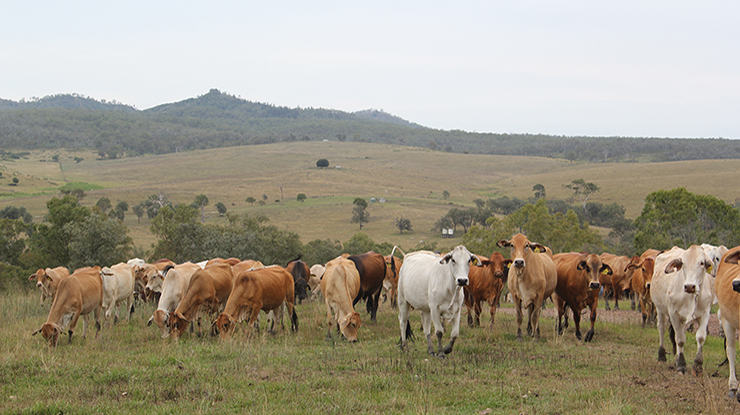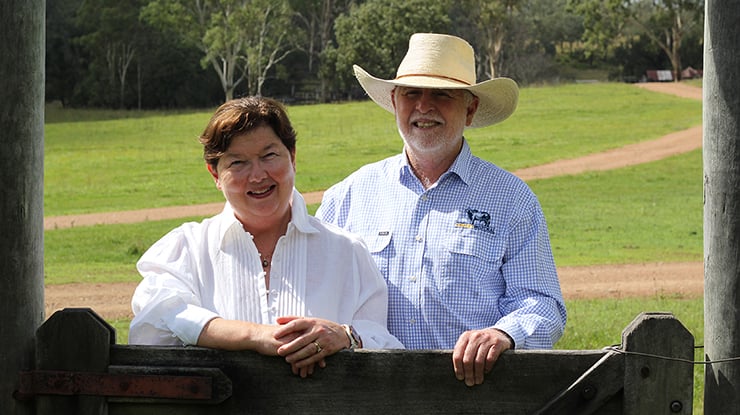 The low-maintenance, tropically adapted herd doesn’t require fly or tick management. Image: Marie Copley.
The low-maintenance, tropically adapted herd doesn’t require fly or tick management. Image: Marie Copley.
Long-term genetic focus helps weather seasons
Key points
- Aim for a low-maintenance, fertile, adaptable herd which will perform even in tough conditions.
- Buy bulls with traits relevant to your production system.
- Your seedstock supplier can assist with your breeding objectives and long-term goals through consulting with you about estimated breeding values when making bull purchasing decisions.
Drafting stock early according to stringent performance and fertility standards has kept the Copleys in a good position to make prudent decisions as the conditions unfold around them. “
We’re working on the assumption that it will remain dry, so even if it ends up raining, our decisions will pay off regardless,” Marie said.
A measured approach
Speaking to Tom and Marie, it’s clear that this well-established couple are on the same page.
“We take a team approach and believe in staying the course. We don’t panic or make decisions reactively based on short-term weather forecasts,” Marie said.
Despite a good autumn top-up in March 2023, it wasn’t enough to make up for the extremely limited rain over the summer. Further low rainfall and frost over winter, tempered by only a limited stormy break in spring, made for sparse pastures.
“We had a cold winter and heavy impact frost, so the remaining pasture was of poor quality. A spring storm gave us more than 100mm which at least changed things up to initiating some early growth,” Tom said.
Target supplementation
In order to utilise the poor-quality frosted pastures, the Copleys used dry lick over the winter of 2023.
“We also supplemented with protein meals, palm kernel extract and some molasses and urea for targeted groups,” Tom said.
They paid special attention to the early calvers who were under the most nutritional stress. “There was virtually no grass growth over winter, so it was especially important that we targeted those animals which needed it most. We drafted the early calvers into their own groups at pregnancy testing – this means we can target our supplementation more effectively,” Tom said.
Segregating the herd according to calving levels and identifying non-performers is a strategy which allows the Copleys to act quickly once conditions start to get tough.
“We make these decisions fairly early. We sell the non-performers – we can then work out our stocking rate and grass budget more efficiently,” Tom said.
Responsive weaning strategy
The Copleys commenced weaning early in December despite not knowing if they would receive much needed rain in early 2024.
This cost-effective approach meant they could direct limited resources to where they would have the most impact. “
Once they’re not lactating, cows can be pretty self-reliant and we can focus our resources on the weaners,” Tom said.
Deciding when to wean the more mature cows usually depends on the seasonal outlook.
“Our plan is for the herd to calve early so we have more options available to us,” Marie said.
Marie and Tom Copley. Image: Marie Copley
The long game
Tom and Marie have a pragmatic approach when it comes to uncertainty around future weather conditions.
“Future proofing denies the future and builds a little wall around yourself, but embracing the future involves creating an efficient herd which can thrive – come what may,” Marie said.
They view the current tough conditions as a litmus test for their genetic decisions. “Dry times can act as an opportunity – it sorts out which females are capable of reproducing despite the far from ideal conditions. We’ll get a certain drop-out rate and won’t keep the dry ones,” Marie said.
Cows who don’t wean a calf or reconceive are sold and the Copleys veer away from providing heavy hay or intensive feeding.
“It’s a targeted approach where we are aiming for a herd which requires minimal assistance,” Marie said.
“It can take up to three years before female calves become part of the breeding herd, so we don’t make decisions reactively based on a good or bad season.”
Tough love
The Copleys don’t compromise when it comes to their fertility expectations, which are closely aligned to the industry’s emission reduction goals.
“Cows need to produce and wean a calf for us each year on time, without assistance and minimal inputs to justify their emissions,” Marie said.
“Going forward, we’ll have to account for their emissions, so they’ve got to be productive, regardless of the season.”
Bull buying
When preparing for the upcoming bull buying season, the Copleys look for fertility indicators such as days to calving. They select bulls from productive cow families who have produced a calf every year, regardless of the quality of season.
“We focus on genetic selections within the 50th to 60th percentile for growth, as moderately framed cows require less feed to maintain good condition compared to larger stock,” Marie said.
“We are wary of the consequences of selecting for high growth. When we look at the cattle who perform year after year – they’re usually moderately sized. Their requirements for growth and maintenance are not huge.”
This approach has paid off with their robust herd able to thrive despite the challenging season.
“They’re not high-maintenance females – they can provide for their calves and reconceive without special conditions. These are the efficient cows we’re focused on producing,” Marie said.
Matching quality bulls with a productive cow herd gives their investment the best chance of performing to its potential.
“One productive bull with all its good traits is not going to solve the problem of an unproductive cow herd. It’s something you need to work on over time,” Tom said.




